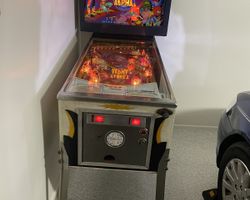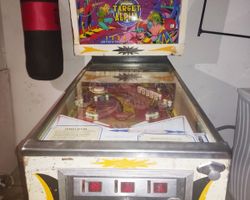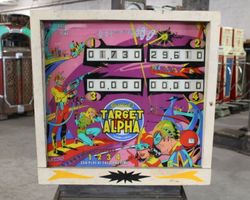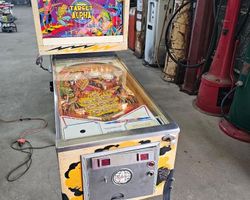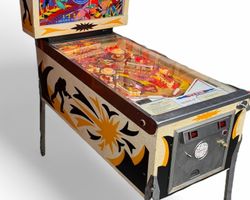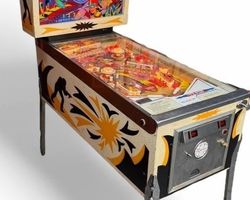Target Alpha
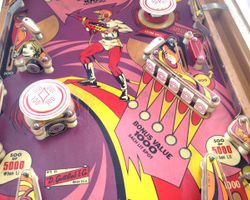
Average Prices: USD $300 to $1,200
Produced: November, 1976
Production Run: 7,285 units
Machine Type: Electro-mechanical
Players: 4
Design by: Ed Krynski
Art by: Gordon Morison
Target Alpha, a four-player electro-mechanical (EM) pinball machine, emerged from the D. Gottlieb & Co. factory in November 1976. This creation, with its striking outer space fantasy theme, represents a significant chapter in Gottlieb's history, showcasing their engineering prowess and artistic vision of the era. The machine's design was helmed by Ed Krynski, a name associated with numerous Gottlieb classics, while the vibrant artwork that adorns the playfield and backglass was the work of Gordon Morison.
Gottlieb, known for its robust and innovative EM designs, produced 7,467 units of Target Alpha, including 182 sample games. This production run indicates a substantial market presence for the machine upon its release. A notable aspect of its design flexibility was its convertibility from replay to add-a-ball operation, a feature that allowed operators to tailor the game's payout structure to different commercial environments. Target Alpha also stands out for its shared playfield design, a characteristic of Gottlieb's production efficiency. Its playfield layout was famously reused across a series of machines, including the one-player 'El Dorado' (1975) and 'Gold Strike' (1975), the two-player 'Solar City' (1977), and even a later four-player solid-state version, 'El Dorado City of Gold' (1984). This commonality in design speaks to the inherent appeal and effectiveness of the layout, a testament to Krynski's work.
Signature Features and Design
The defining characteristic of Target Alpha is its array of drop targets—a total of fifteen distributed across the playfield. These targets, arranged in a prominent ten-bank and a smaller five-bank, are the primary focus of gameplay and the machine’s visual identity. The presence of four flippers further enhances its distinctiveness, with two standard lower flippers and two strategically placed upper flippers designed to facilitate direct shots at the target banks.
The artwork by Gordon Morison contributes significantly to the machine’s appeal. The backglass depicts an engaging space scene, featuring a vibrant alpha numeral target amidst a cosmic backdrop, signaling the game's core objective. The playfield plastics and cabinet art echo this space fantasy theme with bright, saturated colors and futuristic elements. This cohesive artistic vision creates an immersive environment that draws players into the challenge of target elimination. The mechanical reels for scoring, characteristic of EM machines, provide a satisfying tactile and auditory experience as points accumulate. Every successful hit on a drop target is accompanied by the resonant chime of the scoring mechanism, reinforcing player actions.
Playfield and Mechanics
The Target Alpha playfield presents a meticulously crafted layout, renowned for its challenging yet rewarding design. At the heart of the playfield are the two principal drop target banks. The large ten-bank is centrally located, requiring precise shots from the lower flippers or rebounds. To its left, another five-bank of drop targets offers additional scoring opportunities. Flanking these banks are two pop bumpers positioned for lively rebound action, directing the ball unpredictably and creating chaotic sequences that can either assist or hinder target completion. Two slingshots at the lower sides of the playfield provide dynamic deflections, adding to the ball's kinetic energy.
The four-flipper configuration is integral to the playfield’s flow. The lower flippers manage general play and set up long-range shots. The two upper flippers, located near the top of the main drop target array, are positioned for surgical strikes on specific targets within the ten-bank, particularly useful after the ball travels up either of the two return lanes. This strategic placement allows for advanced play, where skilled players can chain shots to clear targets efficiently.
The skill shot at the beginning of each ball, triggered by a precisely launched plunger, aims to hit a specific rollover or target for bonus points, adding an immediate element of challenge. The playfield’s artwork is a blend of bold graphics and intricate details, showcasing Morison’s style. Bright blues, yellows, and reds dominate, enhancing visibility and drawing attention to the various scoring elements. The overall aesthetic is one of vibrant retro-futurism, creating a playful yet competitive atmosphere. The design philosophy clearly emphasizes target-shooting accuracy and strategic flipper work, making every shot count towards clearing the challenging arrays.
Gameplay Dynamics
The core objective of Target Alpha's gameplay revolves around methodically knocking down all fifteen drop targets. Each target hit contributes points, and completing an entire bank, particularly the ten-bank, awards significant bonuses. The game’s progression is tied directly to these targets: the more targets a player eliminates, the higher their score. Points accumulate on mechanical reels, with the bonus multiplier increasing on the final ball, providing an incentive for deep play.
Earning an extra ball is a key objective, achievable by hitting specific rollovers located beyond the drop target banks after completing certain target sequences. This mechanic encourages players to not only focus on the targets themselves but also on ball control to access these bonus-granting lanes. The primary challenge lies in clearing all fifteen drop targets within a single ball, a feat that demands consistent accuracy and strategic flipper control.
A distinctive aspect of Target Alpha, particularly in this four-player replay version, is that the drop targets reset only between balls, not mid-ball. This design choice shapes gameplay strategy. Once a player clears all fifteen targets on a ball, the immediate objective shifts from target elimination to maximizing score through rollover lanes, pop bumper hits, and maintaining ball control until the ball drains. This specific dynamic means players must adapt their strategy once the primary objective is met, focusing on sustaining the ball in play to accumulate remaining points. Despite the shift in focus, the initial drive to clear all targets remains compelling and offers substantial replay value.
Reception and Legacy
Target Alpha has garnered a largely positive reception within the pinball community, cementing its status as a classic electro-mechanical machine. Its strengths are frequently cited, beginning with the sheer satisfaction derived from its fifteen drop targets. Players find the rhythmic thud and visual confirmation of a target falling to be highly addictive, driving repeated plays. The playfield layout is often described as ingenious and well-conceived, a testament to its enduring appeal, evidenced by its reuse in several other Gottlieb titles. This design provides a clear, target-focused gameplay experience that resonates with enthusiasts of the era.
The artwork, particularly the bright and colorful space theme by Gordon Morison, is consistently praised for its vibrancy and retro charm. The four-flipper arrangement, especially the well-placed upper flippers, is highlighted for enabling precise shots and adding depth to the gameplay. The initial skill shot, requiring a precise plunge, adds an engaging start to each ball. As a Gottlieb machine, Target Alpha benefits from a reputation for robust build quality and a relatively straightforward maintenance profile compared to other manufacturers from the same period. Many consider it a good value acquisition for collectors, offering the iconic Gottlieb EM experience without the premium pricing of some of its more scarce counterparts. Its four-player capability also makes it a popular choice for social gatherings and friendly competition. Players often describe the game as challenging, which contributes to its long-term replayability and fosters a desire for mastery.
However, Target Alpha is not without its critical points. The most frequent observation relates to a potential lull in engagement once all fifteen drop targets have been cleared on a single ball, especially since the targets do not reset during play in this version. This can lead to a period where the primary goal is achieved, and subsequent play on that ball becomes focused solely on maintaining the ball in play for bonus points. Another recurring comment pertains to the machine's propensity for quick drains, particularly via the right outlane, which can lead to frustration for players aiming for extended ball times or high scores. While the classic Gottlieb chimes are appreciated by many, some find the sound package to be standard for the era and not particularly distinctive. Despite these points, Target Alpha's legacy remains strong. Its shared playfield layout has become a benchmark in EM design, influencing subsequent Gottlieb machines and solid-state reinterpretations. Its enduring popularity among collectors and players underlines its well-earned place in pinball history as a highly enjoyable and challenging machine.
Sponsored Links
 Ebay Listings
Ebay Listings
 Auction Results
Auction Results
| Cost | Location | Date |
|---|---|---|
| EUR €451 |  Hessen, Germany Hessen, Germany |
30 November, 2025 |
| AUD $1,600 |  Queensland, Australia Queensland, Australia |
25 November, 2025 |
| EUR €604 |  Hessen, Germany Hessen, Germany |
19 November, 2025 |
| USD $1,200 |  New York, United States New York, United States |
19 October, 2025 |
| USD $1,500 |  Minnesota, United States Minnesota, United States |
22 April, 2025 |
| USD $1,500 |  Minnesota, United States Minnesota, United States |
22 April, 2025 |
| USD $700 |  Ohio, United States Ohio, United States |
28 August, 2024 |
| USD $850 |  Wisconsin, United States Wisconsin, United States |
06 March, 2024 |
| USD $900 |  Massachusetts, United States Massachusetts, United States |
05 March, 2024 |
| USD $1,100 |  Illinois, United States Illinois, United States |
30 October, 2023 |


Private Policy · Search Website · Contact Us
As an eBay Partner, we may earn a commission from qualifying purchases made through links on this site, at no additional cost to you.
All trademarks and copyrighted materials remain property of their respective owners. All other content copyright 2007 - 2026 Pinpedia.

